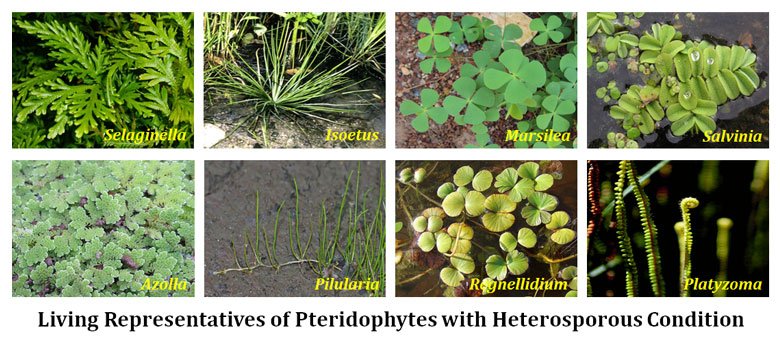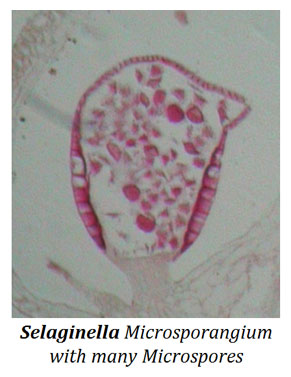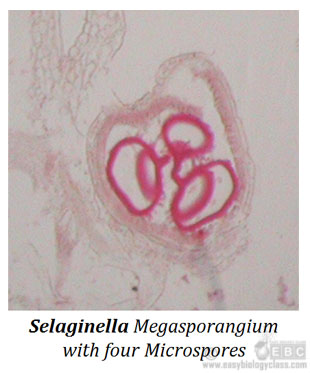Heterospory is the production of two or more types of spores. It is a condition of the production of more than one types (usually two) of spores in a single plant. These two types of spore differ in their formation, structure and most importantly its functions and sexuality. In Pteridophytes, these two spores are called as Microspores and Megaspores. The present post discuss the significance of Heterospory and Seed Habit
(1). Microspores
Microspores are small sized spores produced in large numbers inside the microsporangium. They are male spores which on germination produce male gametophyte.
(2). Megaspores
Megaspores are comparatively large spores produced in limited numbers (1 to 4) inside the megasporangium. They are female spores which on germination produce the female gametophyte.
Learn more: Difference between Microspores and Megaspores
The production of two types of spores with different sexuality was first evolved in Pteridophytes. Even though, the condition of heterospory is now represented only by eight living species of Pteridophytes, they are Selaginella, Isoetus, Marsilea, Salvinia, Azolla, Pilularia, Regnellidium and Platyzoma.

image source: wikipedia
Heterosporous condition has many Advantages over Homospory:
 Heterospory produced the first endosporic (inside the spore wall) type of gametophyte development in land plants. The endosporic gametophytes are independent of the external harsh environmental conditions. Moreover, they have a continuous supply of food material from the diploid sporophytic plant. The homosporous Pteridophytes show exosporic (outside the spore wall) gametophytic development. The exosporic gametophytes have to find the nutrients from the external environment. Thus, the endosporic development is a good starting point for the survival of the young embryo.
Heterospory produced the first endosporic (inside the spore wall) type of gametophyte development in land plants. The endosporic gametophytes are independent of the external harsh environmental conditions. Moreover, they have a continuous supply of food material from the diploid sporophytic plant. The homosporous Pteridophytes show exosporic (outside the spore wall) gametophytic development. The exosporic gametophytes have to find the nutrients from the external environment. Thus, the endosporic development is a good starting point for the survival of the young embryo.
The heterospory also facilitated the sex differentiation in Pteridophytes. In homosporous Pteridophytes, the sex differentiation takes place only during the development of antheridia or archegonia. The heterospory also reduced the size of gametophytic generation. In most of the heterosporous plants, the gametophyte is restricted to very few cells.
Heterospory Advanced to the Seed Habit in Land Plants
One of the most important advantages of heterospory is the formation of seed habit. In homosporous plants, the male and female gametes are formed in the same prothallus. Thus the chance of fertilizing an egg with the sperm of the same prothallus is very high. This reduced the chance of genetic variability among homosporous plants. In heterosporous plants, the male and female gametangia are separated both in time and space. This reduces the chance of self-fertilization and increases the chance of variability in the progenies.
In heterosporous condition, due to the separation of male and female gametophytes, there has to be some mechanism to bring the two compatible gametangia together so that the fertilization can be achieved. This is made possible by the development of pollination mechanism. The indication of the starting of pollination mechanism is observed in Selaginella where a temporary retention of the female gametangia within the megasporanigum is evident.
Seeds have many advantages than spores
 The seed is actually an integumented megasporangium. The seed represents three generations:
The seed is actually an integumented megasporangium. The seed represents three generations:
(1). Parent sporophytic tissue represented by integuments and nucellus.
(2). Gametophytic tissue represented by the female gametophyte.
(3). The offspring sporophyte represented by the embryo.
The formation of seed is one of the greatest evolutionary vents in the phylogeny of seed plants. It is the greatest adaptation of land plants to ensure its reproductive success and survival. The gametophytic generation is a weak link between the sporophyte and seed in the life cycle of terrestrial plants. The chance of the survival of the independent gametophyte is very less. In order to overcome this problem, the female gametophyte is permanently retained in the megasporangium. Thus, the heterosporous condition is considered as precondition for the seed habitat. Moreover, there is no evidence to prove the development of seed habitat from homosporous condition.
The gradual development of seed habitat from heterosporous condition may be occurred in the following steps:
1. Production of two types of spores
2. Reduction in the number of functional megaspores
3. Production of singe megaspore per megasproangium
4. Permanent retention of megaspore within the megasporangium
5. Developments for the availability of sufficient nutrition
6. Formation of protective layers (integuments) around the megasporangium
7. Development of organic connection between the megasporangial wall and the megaspores.
8. Development of pollination mechanism
9. Retention of young embryo inside the megaspore wall
10. Development of seed with protective layers
11. Development of seed dispersal mechanism
Key questions
1. What is Heterospory? What are its significances?
2. What is the evolutionary significance of Heterospory?
3. Differentiate Megaspores and Microscpores.
4. Give the names few Pteridophtyes which shows heterosporous condition.
5. What are the advantages of heterosporous condition over homospory?
6. Describe the advantages of seed habitat
7. What are the possible evolutionary events in the formation of seeds in land plants?
You may also like…
@. Pteridophytes General Characters + PPT
@. Stelar Evolution in Pteridophytes
@. Difference between Bryophytes and Pteridophytes
@. Eusporangium vs Leptosporangium
